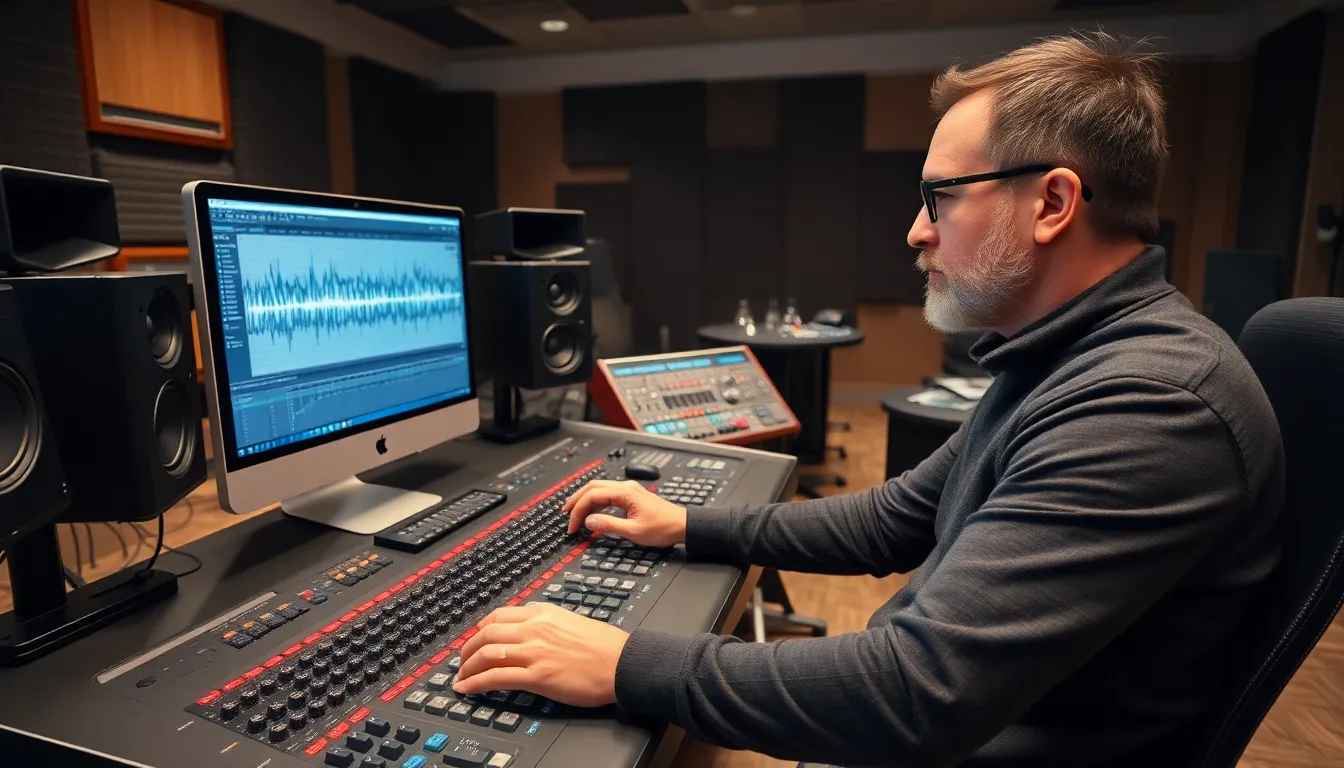In a world where every coffee shop sounds like a rock concert and the neighbor’s dog has a personal vendetta against peace and quiet, audio denoising algorithms come to the rescue. These clever little tools sift through the chaos, transforming garbled sounds into crystal-clear audio. Imagine recording a podcast without the background symphony of lawnmowers and chatty baristas—sounds like a dream, right?
As technology advances, so do the methods for cleaning up audio. From machine learning to spectral subtraction, these algorithms are the secret sauce behind pristine sound quality. Whether you’re a budding musician or a seasoned audio engineer, understanding these techniques can elevate your work from “meh” to “wow.” Buckle up as we dive into the fascinating world of audio denoising algorithms and discover how they can save your sound—one decibel at a time.
Table of Contents
ToggleOverview of Audio Denoising Algorithms
Audio denoising algorithms play a critical role in enhancing sound quality by effectively reducing unwanted noise. Various techniques exist, including spectral subtraction, which analyzes frequency components to identify and eliminate noise while preserving the original audio signal.
Many modern algorithms incorporate machine learning to improve accuracy and efficiency. These systems train on large datasets, allowing them to adapt and learn noise patterns in different environments, making them suitable for diverse applications.
Waveform processing techniques are also commonly used. They manipulate the audio waveform directly, providing real-time denoising solutions suitable for live recordings. Techniques such as time-domain filtering can offer quick fixes for specific noise types, contributing to clearer sound output.
Adaptive filtering adapts to changing noise conditions, optimizing performance in real-time. By continuously adjusting its parameters, this method efficiently responds to various audio scenarios, ensuring superior sound quality during playback or recording.
Another significant approach is deep learning-based methods, which leverage neural networks for advanced audio signal processing. Researchers employ convolutional neural networks for their ability to distinguish between noise and signal, leading to outstanding denoising performance in complex scenarios.
Choosing the right algorithm depends on specific applications and required outcomes. Engineers across audio production fields, from music recording to spoken word applications, benefit from a tailored approach that meets unique sound quality demands. Understanding these algorithms allows audio professionals to achieve the best results in noise reduction, enhancing overall listening experiences.
Types of Audio Denoising Algorithms

Audio denoising algorithms vary significantly in their methods and applications, each offering unique advantages. Below are some prominent types used in the field.
Spectral Subtraction
Spectral subtraction analyzes audio signals in the frequency domain. This technique estimates the noise spectrum during silent parts and subtracts it from the noisy signal. Users find that this method effectively reduces steady-state noise while preserving key audio characteristics. The algorithm computes a clean estimate of the audio waveform, making it particularly useful in environments with constant noise, such as air conditioning or traffic sounds. Many audio engineers utilize this method due to its simplicity and effectiveness.
Wavelet Transform
Wavelet transform provides a multi-resolution analysis of audio signals. The approach decomposes the signal into its wavelet coefficients, capturing both frequency and time information. Users appreciate the ability to target specific frequency bands, allowing for precise noise reduction without losing important audio details. This technique excels in handling transient noises, making it suitable for complex recordings such as musical performances. Many professionals adopt wavelet transform as a versatile alternative to traditional denoising techniques.
Deep Learning Approaches
Deep learning approaches utilize neural networks for sophisticated audio processing. These methods train on extensive datasets, enabling them to learn and adapt to various noise patterns. Users benefit from the high level of detail and accuracy achieved through these models. This technique excels in differentiating between noise and the desired audio signal, making it a powerful choice in challenging scenarios. Numerous audio professionals are increasingly adopting deep learning methods for their advanced capabilities and impressive results in noise reduction.
Applications of Audio Denoising Algorithms
Audio denoising algorithms play essential roles in various fields, significantly enhancing sound quality and clarity. Their adaptability enables effective use in diverse applications, including music production and speech enhancement.
Music Production
In music production, these algorithms improve recorded tracks by eliminating unwanted background noise. Clear vocals are essential, and denoising techniques ensure they shine through layers of instruments. Engineers employ spectral subtraction to remove hiss or buzz from recordings while preserving tonal integrity. Advanced deep learning methods offer remarkable results, allowing for complex audio environments to be processed seamlessly. Experienced producers often rely on time-domain filtering for real-time noise management during live performances. Ultimately, the choice of denoising method depends on the specific requirements of the track and the desired listening experience.
Speech Enhancement
Speech enhancement benefits greatly from audio denoising algorithms, improving clarity in conversations and audiovisual presentations. Meeting environments often contain distracting background sounds, and these algorithms reduce such interferences, making spoken words easier to understand. Techniques like adaptive filtering dynamically respond to varied noise conditions, ensuring speech remains intelligible. Machine learning approaches help distinguish between speech patterns and extraneous noise, providing impressive clarity. Many industries, including telecommunications and broadcasting, depend on these technologies to maintain high-quality audio experiences. Effective speech enhancement underscores the value of clear communication in professional and personal interactions.
Comparative Analysis of Audio Denoising Algorithms
Understanding the performance of audio denoising algorithms is crucial for selecting the most effective method for specific applications. Evaluating these algorithms often involves several key performance metrics.
Performance Metrics
Signal-to-noise ratio (SNR) quantifies how much noise exists in relation to the desired signal. Mean opinion score (MOS) assesses subjective listener experiences, providing insights into audio quality improvements. Processing time indicates how quickly an algorithm can operate, especially critical in real-time applications. Another metric is perceptual evaluation of speech quality (PESQ), which gauges the intelligibility of speech after processing. These metrics offer a comprehensive understanding of how effectively different denoising methods function in various scenarios.
Advantages and Limitations
Several factors contribute to the advantages of various audio denoising algorithms. Spectral subtraction excels in reducing steady-state noise, making it a common choice among audio engineers. Wavelet transform offers precise noise reduction without compromising audio details. Deep learning methods deliver outstanding performance in complex environments due to their advanced training on extensive datasets. Limitations also exist, such as the computational complexity of deep learning models requiring significant resources. Furthermore, spectral techniques may introduce artifacts if not implemented carefully. Those seeking to optimize audio quality must recognize the trade-offs involved in choosing the right algorithm for their specific needs.
Audio denoising algorithms play a crucial role in enhancing sound quality across various environments. By leveraging advanced techniques such as machine learning and spectral subtraction, these algorithms ensure clearer recordings and improved listening experiences. As audio professionals navigate the complexities of different methods, understanding the unique advantages and limitations of each algorithm becomes essential.
With a variety of options available, from adaptive filtering to deep learning approaches, selecting the right technique can significantly impact audio production and speech clarity. By staying informed about the latest developments in audio denoising technologies, individuals can optimize their work and elevate the quality of their audio outputs.




